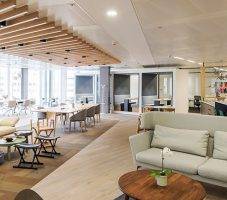August 30, 2016
Overwork leads to sleeplessness and lower workplace productivity 0
 A new study claims that there is a direct link between sleep and productivity. A survey of more than 97,000 employees in 33 industries and 139 countries from Global Corporate Challenge (GCC), found evidence of a link between sleep and performance. Currently, one in three adults regularly fail to get enough sleep, according to the US’ Centers for Disease Control and Prevention (CDC); and Harvard Medical School estimates that the cost adds up to USD $63.2 billion annually. This includes money lost through absenteeism as well as the accidents, mistakes, and impaired productivity employees suffer when they do show up to work. And the one of the primary causes is working long hours and forms of presenteeism such as checking emails at home. To help combat this problem the report urges those at the top of the organisation to set an example and demonstrate that working long hours in exchange for reduced sleep is counterproductive and won’t be encouraged.
A new study claims that there is a direct link between sleep and productivity. A survey of more than 97,000 employees in 33 industries and 139 countries from Global Corporate Challenge (GCC), found evidence of a link between sleep and performance. Currently, one in three adults regularly fail to get enough sleep, according to the US’ Centers for Disease Control and Prevention (CDC); and Harvard Medical School estimates that the cost adds up to USD $63.2 billion annually. This includes money lost through absenteeism as well as the accidents, mistakes, and impaired productivity employees suffer when they do show up to work. And the one of the primary causes is working long hours and forms of presenteeism such as checking emails at home. To help combat this problem the report urges those at the top of the organisation to set an example and demonstrate that working long hours in exchange for reduced sleep is counterproductive and won’t be encouraged.











 Badly run and overrunning meetings remain amongst the main sources of workplace conflict and unhappiness, according to a study of 1,000 US employees from workplace software provider
Badly run and overrunning meetings remain amongst the main sources of workplace conflict and unhappiness, according to a study of 1,000 US employees from workplace software provider 


 Small business owners are working thirteen hours a week more than the UK average, negatively impacting the health of nearly a third (28 percent) of them, according to a survey commissioned by business marketplace Bizdaq. According to
Small business owners are working thirteen hours a week more than the UK average, negatively impacting the health of nearly a third (28 percent) of them, according to a survey commissioned by business marketplace Bizdaq. According to 
 Fifteen million UK internet users have undertaken a ‘digital detox’ in a bid to strike a healthier balance between technology and life beyond the screen, according to a new Ofcom study. The study of around 2,500 people suggests that our reliance on the internet is affecting people’s personal and working lives, leading many to seek time away from the web to spend time with friends and family. Ofcom’s
Fifteen million UK internet users have undertaken a ‘digital detox’ in a bid to strike a healthier balance between technology and life beyond the screen, according to a new Ofcom study. The study of around 2,500 people suggests that our reliance on the internet is affecting people’s personal and working lives, leading many to seek time away from the web to spend time with friends and family. Ofcom’s 
 Office politics is the one thing many young people are least prepared for when starting their first job, according to a new study by the Co-op. The study comes as many them are about to enter the workforce for the first time. With more young people opting for the world of work in the form of apprenticeships and on the job training rather than higher education, the members of ‘Generation Y’ often find they are unprepared for these softer skills needed to get on in the office according to the poll of 1,100 16-25 year olds. Over half of young people (54 percent) said that they were not prepared or informed about office politics. The study is part of the Co-op’s campaign to champion young people in the workplace by taking a closer look at what motivates 16-25 year olds. The research suggests that young people could find it harder to express opinion and ideas in the workplace, which in turn could lead them to feel isolated and unsupported.
Office politics is the one thing many young people are least prepared for when starting their first job, according to a new study by the Co-op. The study comes as many them are about to enter the workforce for the first time. With more young people opting for the world of work in the form of apprenticeships and on the job training rather than higher education, the members of ‘Generation Y’ often find they are unprepared for these softer skills needed to get on in the office according to the poll of 1,100 16-25 year olds. Over half of young people (54 percent) said that they were not prepared or informed about office politics. The study is part of the Co-op’s campaign to champion young people in the workplace by taking a closer look at what motivates 16-25 year olds. The research suggests that young people could find it harder to express opinion and ideas in the workplace, which in turn could lead them to feel isolated and unsupported.
 SMEs that neglect to offer flexible work options may find their employees decide to switch to somewhere that does, according to a survey from
SMEs that neglect to offer flexible work options may find their employees decide to switch to somewhere that does, according to a survey from 











August 16, 2016
A well executed wellness strategy benefits staff and employers 0
by Beate O'Neil • Comment, Wellbeing, Workplace
(more…)